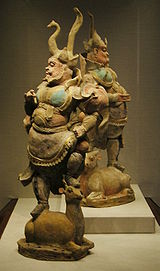| This article includes a list of general references, but it lacks sufficient corresponding inline citations. Please help to improve this article by introducing more precise citations. (April 2011) (Learn how and when to remove this message) |



Lokapāla (Sanskrit: लोकपाल, Tibetan: འཇིག་རྟེན་སྐྱོང་བ, Wylie: 'jig rten skyong ba), Sanskrit, Pāli, and Tibetan for "guardian of the world", has different uses depending on whether it is found in a Hindu or Buddhist context. In Hinduism, lokapāla refers to the Guardians of the Directions associated with the eight, nine and ten cardinal directions. In Buddhism, lokapāla refers to the Four Heavenly Kings, and to other protector spirits, whereas the Guardians of the Directions are referred to as dikpāla.
In Hinduism
Main article: Guardians of the directionsIn Hinduism, the guardians of the cardinal directions are called dikapāla. The four principal guardians are:
In Buddhism
In Buddhism, lokapāla are one of two broad categories of dharmapāla (protectors of the Buddhist religion) -the other category being Wisdom Protectors. In China, "each is additionally associated with a specific direction and the Four Heraldic Animals of Chinese astronomy/astrology, as well as playing a more secular role in rural communities ensuring favorable weather for crops and peace throughout the land...Easily identified by their armor and boots, each has his own magic weapon and associations." Their names are (east) Dhrtarastra, (west) Virupaksa, (north) Vaishravana, and (south) Virudhaka.
In Tibetan Buddhism, many of these worldly protector deities are indigenous Tibetan deities, mountain gods, demons, spirits or ghosts that have been subjugated by Padmasambhava or other great adepts and oath bound to protect a monastery, geographic region, particular tradition or as guardians of Buddhism in general. These worldly protectors are invoked and propitiated to aid the monastery or Buddhist practitioner materially and to remove obstacles to practice. However, since they are considered to be Samsaric beings, they are not worshiped or considered as objects of refuge.
According to Tripitaka Master Shramana Hsuan Hua of the City of Ten Thousand Buddhas, all of these beings are invoked (hooked and summoned) and exhorted to behave (subdued) and protect the Dharma and its practitioners in the Shurangama Mantra.
References
- Welch, Patricia Bjaaland. Chinese Art: A Guide to Motifs and Visual Imagery. Vermont: Tuttle, 2008, p. 194.
- Hua, Gold Mountain Shramana Tripitaka Master Hsuan; Bhikshuni Rev. Heng Chih; Bhikshuni Rev. Heng Hsien; David Rounds; Ron Epstein; et al. (2003). The Shurangama Sutra - Sutra Text and Supplements with Commentary by the Venerable Master Hsuan Hua - First Edition. Burlingame, California: Buddhist Text Translation Society. ISBN 0-88139-949-3. Archived from the original on 2009-05-29., Volume 6, Chapter 3: The Spiritual Shurangama Mantra, pp. 87-162, and Chapter 5, The Twelve Categories of Living Beings, pp. 177-191,
Further reading
- Kalsang, Ladrang (1996) The Guardian Deities of Tibet Delhi: Winsome Books. (Third Reprint 2003) ISBN 81-88043-04-4
- Linrothe, Rob (1999) Ruthless Compassion: Wrathful Deities in Early Indo-Tibetan Esoteric Buddhist Art London: Serindia Publications. ISBN 0-906026-51-2
- De Nebesky-Wojkowitz, Rene. (1956) Oracles and Demons of Tibet. Oxford University Press. Reprint Delhi: Books Faith, 1996 - ISBN 81-7303-039-1. Reprint Delhi: Paljor Publications, 2002- - ISBN 81-86230-12-2
External links
- Buddhist Protectors - outline page at Himalayan Art Resources
- Buddhist Protectors: Worldly - images at Himalayan Art Resources
- Lokapalas and caturmaharajikas - Lokapalas and caturmaharajikas in rock carvings at Chilas and Thalpan on the Upper Indus (Pakistan)